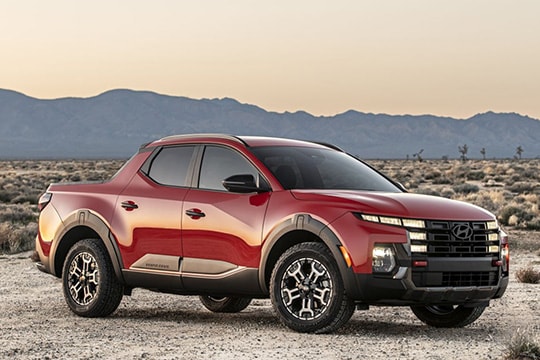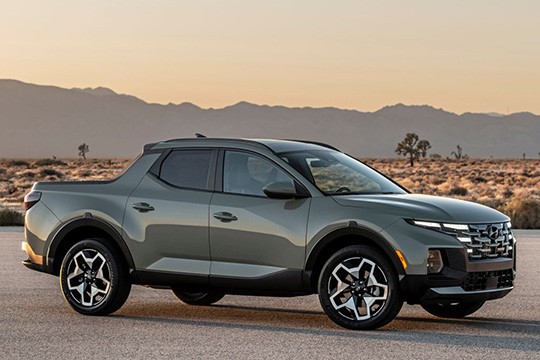HYUNDAI Santa Cruz Models/Series Timeline, Specifications & Photos
First production year: 2021
Engines: Gasoline
Body style: Truck
Hyundai had updated its Santa Cruz lineup for the 2025 model year, and while the exterior changes were minor, the interior was fresh, and the powertrain was improved for better towing abilities.
In 2021, Hyundai launched the Santa Cruz pickup, which was revealed as a concept car in 2015. Six years later, the automaker released the production version, and customers were pleased. It was another compact pickup based on a unibody platform instead of being traditionally built on a body-on-frame structure. As a result, it had to compete against the Honda Ridgeline and, later, with the Ford Maverick. Come 2024, the Korean automaker refreshed the lineup after it listened to its customers. As a result, the Sport Adventure Vehicle, as Hyundai likes to name its truck, became friendlier with its passengers. Unfortunately, it didn’t show up with a hybrid drivetrain as expected, even though the Santa Cruz shared its platform with the Tucson, which was available with such a unit.
Hyundai knew that the car’s front fascia had to be refreshed to be noticed as a facelifted model. As a result, the main grille featured rectangular blocks, and the daytime running lights sported the same shapes. These were still integrated and looked like nothing else on the market. The XRT grade featured a new lower skid plate under the bumper and looked tougher than before.
The four-door pickup kept the same athletic posture from its profile, with sculptured door panels and plastic moldings around the wheel arches and side sills. Furthermore, the automaker provided the car, as an option, with all-terrain tires, which made the Santa Cruz more capable while off-roading. The contrasting door mirrors and handles were kept since customers loved the way they looked.
Inside, the 2025 Santa Cruz had a fresh interior. Its dashboard wasn’t as much divided as before. The same curved piece of glass covered the available 12.3-inch instrument panel and the 12.3-inch touchscreen for the infotainment system. All grades came fitted with standard wireless Apple CarPlay and Android Auto. In addition, Hyundai replaced some of the touch controls previously used on the 2021 Santa Cruz with physical buttons, significantly improving ergonomics. But still, the gear selector was in the same position, between the front seats, housed by the center console. In the back, customers were pleased by the storage area underneath the bench seat, so that feature was kept. In addition, the automaker added a folding armrest featuring two cup holders for the rear-seated passengers.
Hyundai placed the same 2.5-liter four-banger engines under the hood of the Santa Cruz, available with or without turbocharging. The automaker also added a towing program for the powertrain to ease customers’ lives while a trailer was attached to their vehicle. The tow rating remained the same, though, with 2,500 lbs. (1,134 kg) for the naturally aspirated version and 5,000 lbs. (2,268 kg) for the turbocharged one.
Hyundai broke new grounds when it introduced the Santa Cruz in its lineup and opened the gates for new, compact pickups.
Unlike most pickups on the market, the Santa Crus was based on a unit-body construction, like the Honda Ridgeline, except that it was smaller. The Korean carmaker showed the concept vehicle in 2015 but waited another six years to unveil the production model. It was an innovative vehicle, and Hyundai called it a Sport Adventure Vehicle.
Its front fascia was unique on the market. It featured a broad grille with dark-chromed elements. Between them, it installed a few LED daytime running lights, not only two like anyone else but four on each side! On the lower side of the bumper, on the outer areas, the carmaker installed the headlights. From its sides, the car revealed its half-SUV and half-pickup shape. Its four feet bed (1,220 mm) featured a smaller trunk under the floor, on the rear side.
Inside, Hyundai stepped up the game and installed a fully digital dashboard, with a 10.2" TFT screen in front of the driver and a standard eight-inch infotainment display on top of the center stack. A 10.2" touch-screen was available on the options list. Underneath the infotainment display, the carmaker installed another touch-screen for the climate control unit. In their quest for a digital future, Hyundai's designers deleted the volume knobs. For seating, the carmaker installed a pair of bucket seats at the front and a folding bench in the back. The latter featured a lifting system, something like Honda's Magic Seats mechanism, which revealed a few storage areas for items that shouldn't be kept in the bed.
For the Santa Cruz, Hyundai installed a four-pot engine, with or without a turbocharger. Both versions were paired to an eight-speed automatic (dual-clutch) gearbox that sent the power in all corners.

